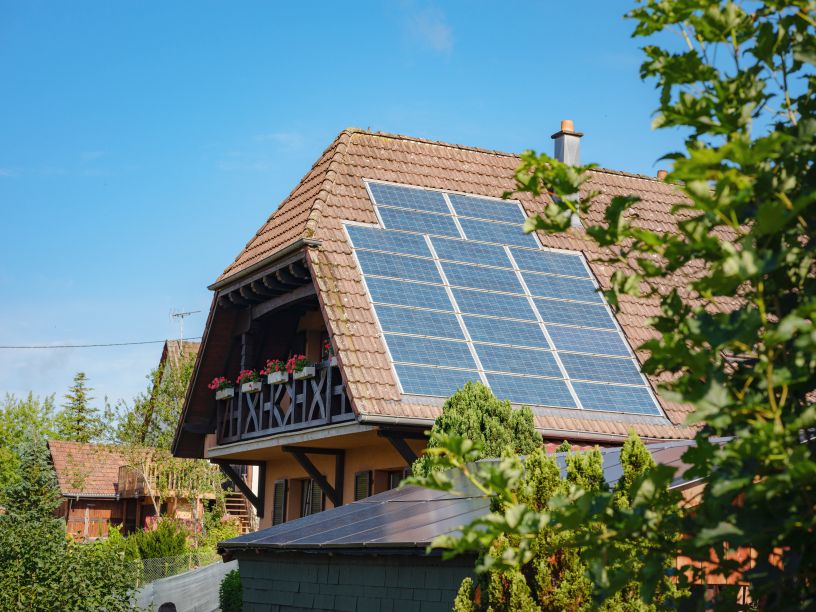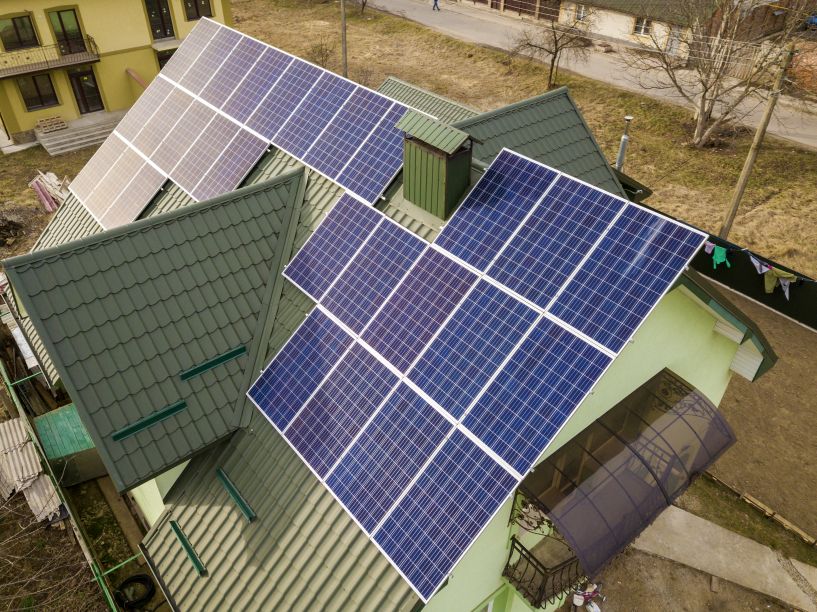How big are solar panels – and will they fit on your roof?
That’s one of the first questions homeowners ask when considering solar. In 2025, the average residential solar panel measures about 65 x 39 inches (1.65 x 1 meter), weighs around 40 pounds (18 kg), and produces roughly 400 watts. But size alone doesn’t tell the full story. The right system for your home depends on how efficiently those panels convert sunlight, how long they’re backed by warranties, and how well they’re installed to maximize your roof space.
In this guide, we’ll break down solar panel dimensions, compare different sizes, and show you how many panels typically fit on a roof. By the end, you’ll know exactly which option makes sense for your home and how to take the next step toward saving with solar.

TL;DR – Key Takeaways for Homeowners In Massachusetts
The average residential solar panel measures about 65 x 39 inches and produces roughly 400 watts. But when it comes to solar, bigger isn’t always better — efficiency, warranties, and installer expertise usually matter more than raw dimensions. Most homes end up needing 15–25 panels, depending on roof size, shading, and household energy use.
The smartest move is to get a custom solar quote. That way, you’ll know exactly which panel size and system design will deliver the best savings for your roof.
Quick Facts – Standard Solar Panel Sizes at a Glance
When homeowners ask about solar, one of the first things they want to know is how physically large the panels are. Solar panels generally fall into three categories: residential, commercial, and portable solar panels. While dimensions can vary slightly by manufacturer, the ranges below are industry standards in 2025.
| Panel Type | Typical Dimensions | Weight | Power Output (Wattage) | Best Use Case |
| Residential (60–66 cell) | ~65 x 39 in (1.65 x 1 m) | 18–20 kg (40–44 lbs) | 350–450W | Most standard home rooftops |
| Commercial (72–78 cell) | ~78 x 39 in (2 x 1 m) | 23–25 kg (50–55 lbs) | 450–600W | Larger homes, businesses, or ground mounts |
| Portable Solar Panels | 25–50 in (varies, often foldable) | 2–10 kg (5–22 lbs) | 50–300W | RVs, camping, boats, small off-grid use |
For homeowners, the residential 60–66 cell panel is the most common choice, offering a practical balance between size, efficiency, and ease of installation. Larger commercial panels can generate more power per unit but require more roof space and are harder to handle during installation. Portable panels, while convenient for travel, aren’t designed to power an entire home.
By starting with these quick facts, you can see exactly what kind of panel is likely to fit your roof and meet your energy needs.
Why Panel Size Matters for Homeowners
When choosing solar panels, size isn’t just a technical detail — it directly affects how well your system works on your roof.
For homeowners with smaller or shaded roofs, compact high-efficiency panels are often the smarter choice. They allow you to generate more electricity in less space, ensuring you still meet your household’s energy needs.
From an installation perspective, larger panels can reduce the total number of units needed, which may lower hardware costs. However, they are heavier and more challenging to handle, which can impact installation time and labor.
Aesthetics also play a role. Larger panels create fewer seams, which many homeowners find looks sleeker and more uniform from the street.
Finally, future-proofing your solar system means striking the right balance between size and efficiency. Panels that maximize output without overcrowding your roof can extend your system’s life, improve return on investment, and keep your home ready for future energy needs.
60-Cell vs 72-Cell Panels – Pros & Cons
When comparing solar panel options, the biggest distinction is between 60–66 cell panels (standard for homes) and 72–78 cell panels (common for commercial or large residential projects).
60–66 cell panels are the go-to choice for most homeowners. They measure about 65 x 39 inches, are lighter and easier to install, and typically produce 350 – 450 watts each. Their manageable size makes them ideal for fitting onto roofs with chimneys, vents, or other obstructions.
72 – 78 cell panels are larger, measuring roughly 78 x 39 inches. They can produce 450 – 600 watts per panel, which means fewer panels are needed for the same total system output. However, their extra size and weight make them harder to handle and less practical for smaller rooftops.
| Panel Type | Roof Space Efficiency | Cost per Watt | Handling Difficulty |
| 60–66 Cell (Residential) | Works well for small/medium roofs | Slightly higher | Easy – lighter and smaller |
| 72–78 Cell (Commercial) | Better for large, open roofs | Lower per watt | Harder – heavier and bulkier |
Homeowner takeaway: Unless you have a very large roof with plenty of open space, 60–66 cell panels are usually the best fit. They balance efficiency, ease of installation, and aesthetics, making them the most common choice for residential solar in 2025.

Measuring Your Roof for Solar Panel Fit
Before deciding which solar panels to install, it’s important to understand how many will actually fit on your roof. A few simple steps can give you a rough estimate:
Step 1: Measure usable roof space. Multiply the length and width of the sections that get consistent sunlight. Focus only on flat, unshaded areas.
Step 2: Factor in tilt and obstructions. Roof angles, chimneys, skylights, and vents all reduce the space available for panels.
Step 3: Allow clearance. Building and fire safety codes typically require at least one foot of clearance around roof edges and ridges.
As a rule of thumb, the average home can fit 15–25 panels, depending on panel size and efficiency. For example, 20 standard 400W panels would create an 8kW system — enough to power many medium-sized households.
Curious how many panels fit on your roof in Massachusetts? [Get a free custom solar estimate today.]
Portable Solar Panels – How Big Are They?
Not all solar panels are designed for rooftops. Portable solar panels are popular with RV owners, boaters, and campers who need quick, renewable power on the go. These panels are much smaller, typically ranging from 25 to 50 inches across, and many are foldable for easy storage and transport. Power output usually falls between 50 and 300 watts, making them ideal for charging small electronics, running portable fridges, or topping up 12V batteries.
However, it’s important to note that portable solar panels are not a full-house solution. They serve as convenient, lightweight options for off-grid adventures, not for replacing your home’s electricity needs.
Why Panel Size Isn’t Everything (Efficiency, Warranties & Quality)
While panel size gives you a starting point, it’s not the only factor that determines how much energy, or savings, you’ll get from your solar system.
Efficiency matters most. A smaller, high-efficiency panel can generate more electricity per square foot than a larger, cheaper panel with lower efficiency. For homeowners with limited roof space, choosing panels in the 20-23% efficiency range can make a big difference in overall system performance.
Durability and warranties are equally critical. Solar panels are a 20–25 year investment, and long-term value depends on how well they hold up. Look for product warranties (covering defects) and performance warranties (ensuring energy output doesn’t drop too quickly). A panel that’s slightly smaller but backed by a 25-year warranty may save you far more over time than a bigger panel with weaker coverage.
Finally, the installer’s design and layout choices often matter more than the panels themselves. A skilled installer will optimize tilt, spacing, and wiring to ensure your system performs at its peak, regardless of panel size.
Takeaway for homeowners: Panel size gets you in the door, but efficiency, warranty strength, and installer expertise are what truly drive your long-term savings.
How to Choose the Best Solar Panel Size for Your Home
The right solar panel size for your home depends on more than just physical dimensions. To make the best choice, you’ll want to consider three main factors:
- Roof space: Smaller or shaded roofs often benefit from compact, high-efficiency panels that maximize power per square foot. Larger roofs may have more flexibility to use bigger panels.
- Household energy consumption: Review your last 12 months of electricity bills to find your total kWh usage. This tells you how much solar you’ll need to offset.
- Budget & financing: Sometimes the “best” panels aren’t the cheapest upfront, but with tax credits, rebates, or financing, higher-efficiency options can deliver stronger lifetime savings.
For example, using 400W panels, a system with 15 panels equals about 6kW, which is a solid fit for many medium-sized households. A larger home with higher energy use may need 20–25 panels.
Recommendation: Work with a local installer who can balance panel size, efficiency, and available incentives. A professional layout ensures your system is designed to meet your family’s unique energy goals – without wasting roof space or money.
FAQs – Solar Panel Size & Dimensions
Q1: What is the average size of a residential solar panel?
The typical home solar panel in 2025 measures about 65 x 39 inches (5.4 x 3.25 feet), weighs around 40 pounds, and produces roughly 400 watts of power.
Q2: How many solar panels does the average house need?
Most homes need between 15 and 25 panels, depending on roof size, sunlight exposure, and annual electricity usage.
Q3: Are bigger solar panels always better?
Not necessarily. Larger panels can produce more power per unit, but high-efficiency smaller panels often deliver better performance for roofs with limited space.
Q4: Can I install commercial-sized panels on my home?
Yes, but it’s usually not recommended. 72–78 cell panels are heavier and harder to install on smaller roofs. Most homeowners are better served with 60–66 cell panels.
Q5: How do I know what size solar system I need?
The best way is to review your electricity bills (kWh/year) and work with a local installer who can design a system that fits your roof and energy needs.
Ready to Size Solar Panels for Your Roof? Get a Free Quote
Choosing the right solar panel size doesn’t have to be complicated. At EcoSunWorks, we connect homeowners like you with trusted local installers who know how to design systems that fit your roof, your budget, and your long-term energy goals. With today’s incentives, rebates, and tax credits, there’s never been a better time to switch to solar.
Your roof, your savings. Get a no-obligation solar quote today and see how much you could save with the right-sized system for your home. Call us right now to get 2-3 instant quotes.
